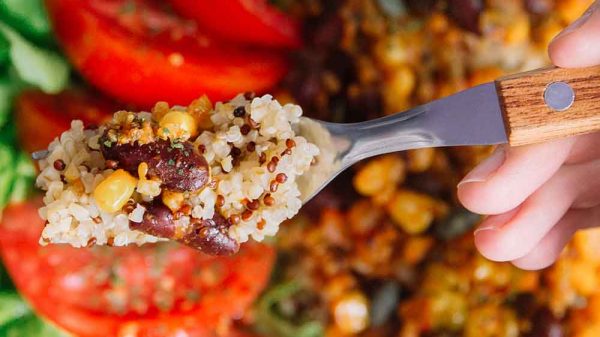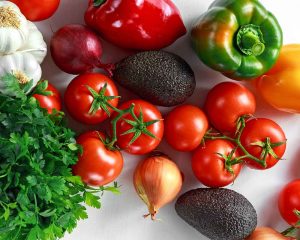Cheese is a popular part of the American diet – you’d be hard-pressed to find an American staple food without cheese. From pasta dishes to burgers, we love our cheese. But is cheese bad for you? And does cheese have protein?
The short answer is yes, cheese contains protein, but the full answer isn’t quite as simple. Here we go through everything you need to know about cheese, its protein content, and the part it should play in your diet.
Protein Content of Cheese
Not only does cheese contain a high quantity of protein, but the protein in cheese is also an excellent source of high-quality protein as well. The protein digestibility corrected amino acid score (PDCAAS) evaluates different food sources based on the bioavailability of the essential amino acids. We must consume nine amino acids through our diet, which is why these amino acids are called “essential.” The remaining 11 amino acids necessary for human biological function can be produced through our body’s metabolic processes, in addition to being present in food.
The nine essential amino acids are histidine, leucine, isoleucine, valine, methionine, lysine, tryptophan, threonine, and phenylalanine. Across the board, all cheese contains ideal amounts of these amino acids.
The proteins found in cheese are casein and whey, both of which have a PDCAAS of 1.00 (which can also be thought of as 100%). This is the highest possible score and indicates that both casein and weight contain optimal amounts of all essential amino acids. (1)
For comparison, a protein source that contains inadequate amounts of the essential amino acids would have a PDCAAS less than 1. For example, wheat gluten has a PDCAAS of 0.25 and peanuts have a PDCAAS of 0.52. (1)
If you’re wondering exactly how much protein is in cheese, the U.S. Department of Agriculture stores information on the nutrient content of hundreds of thousands of foods, through the FoodData Central portal. (2) Using this online database, we’ve compiled the protein content of some of the most popular cheeses.
Here is the protein content per 100g of each kind of cheese, which is equivalent to about 1 cup or 3.5 ounces. Eating 100g of cheese in one sitting is not recommended; we included the amounts per 100g to provide a standardized unit of comparison. All cheese is made from cow’s milk unless otherwise specified.
- Parmesan: 32.1 g protein
- Ricotta: 7.27 g protein
- Cottage: 10.49 g protein
- Cheddar: 22.87 g protein
- American: 15.79 g protein
- Mozzarella: 20g protein
- Blue cheese: 21.43g protein
- Feta: 17.86g protein
- Goat cheese: 25g protein
- Gouda: 25 g protein
- Swiss: 28.57g protein
- Gruyere: 28.57g protein
- Romano: 28.57g protein
- Cream cheese: 7g protein
What Exactly Is Cheese and Why Does It Have So Much Protein?
The high protein content in cheese is related to the cheese-making process. Cheese is made from milk, and to understand the ingredients in cheese, it’s helpful to understand the components of milk.
Components of Milk
- Fat: The main fat present in milk is saturated fat. This kind of fat is characterized by carbon chains that are bonded to the maximum number of hydrogen atoms possible.
- Lactose: This is the kind of sugar present in milk, and although only a small amount is in milk, it is an essential food for bacteria involved in cheesemaking. You may have heard people say that they are lactose intolerant. This means they experience digestive issues after they eat dairy foods containing lactose.
- Protein: The proteins in milk come from casein and whey. Approximately 80% of milk protein is casein, while about 20% is whey.
- Minerals: Calcium, as well as phosphorus, is present in milk. This is why drinking milk and eating cheese and yogurt is associated with growing strong bones. (3)
So how does milk become cheese?
The Cheesemaking Process Isolates Protein
The first step in making cheese is to coagulate the milk. This step is crucial because it isolates milk protein, fat, minerals, and lactose from water. The three milk coagulation methods are acid coagulation, acid and heat coagulation, and rennet coagulation. In acid coagulation, lactic acid bacteria transform the lactose sugar into lactic acid. This acidic product chemically changes casein proteins, causing them to stick together and separate from water. This process is often called “curdling.” Acid-coagulated cheeses tend to be softer and eaten fresh, instead of aged. Common acid-coagulated cheeses include cream cheese and cottage cheese. (3)
Acid/heat coagulation is very similar to acid coagulation, with the additional step of heating the cheese. Lactic acid bacteria or a mild acid like lemon juice is used to separate the solid milk components from water. The combination of acidification and heat produces cheese curds that are then drained to remove excess water. Like acid coagulated cheeses, these cheeses tend to be softer and eaten fresh. Common cheeses produced through acid and heat coagulation include ricotta cheese and queso. (3)
Rennet coagulation is a more convoluted process and is the primary method for producing harder, aged cheeses. Rennet refers to enzymes – from plants, animals, or microorganisms – that chemically change the casein found in milk. After milk is exposed to rennet, casein curdles just like it does in that acid coagulation process. Heat is applied, and excess moisture is removed from the cheese curds. Cheese is then salted and aged. In addition to making cheese tasty, salt is also chemically relevant to creating specific types of cheese and can influence moisture and whey content. Common cheeses made using rennet coagulation include parmesan, cheddar, and gouda. (3)
Keep in mind that these are the three significant categories of cheesemaking processes. Variations in temperature, acid pH, aging time, moisture level, salt content, strain of bacteria, and type of enzyme contribute to the vast array of cheeses we have access to today.
Either way, regardless of the process used, cheesemaking results in a high-protein product. In general, harder, lower-moisture cheeses will be more protein-dense than cheeses with more moisture.
Other Pros to Cheese Consumption
In addition to providing lots of amino acids needed for healthy growth, cheese, and other dairy products are often the main providers of other essential nutrients like vitamin D and calcium. Vitamin D and calcium are vital to supporting bone health, lowering the risk of autoimmune disease, and lowering inflammation.
Certain steps in the coagulation process also influence the calcium content of cheese. Cheese that has been coagulated using rennet tends to have a higher calcium content than cheese that has been coagulated through acidification. Since acid coagulation takes many hours, minerals can be lost in the process. (3)
Downsides to Eating Cheese
Despite the high protein quality and quantity in cheese, there are many cons to consuming cheese.
Keep in mind the following facts when picking out your cheese at the store.
Cheese Often Contains Lots of Sodium
Remember that salting step used in many cheeses, that used to create a desired texture and taste? Despite being high in protein and calcium, many cheeses contain a high level of sodium. If you like to add parmesan cheese to your salads, soups, and pasta, just 1 ounce can have over 400 milligrams of sodium. Adding other types of cheese throughout your day – such as cheese on scrambled eggs or on a sandwich – can easily increase your sodium intake beyond the healthy limit.
High sodium intake leaves you at risk for hypertension, or high blood pressure. Ingesting too much salt causes your body to retain excess water, in order to maintain homeostasis. As a result, your blood volume remains high and puts pressure on your blood vessels. Over time, your blood vessels become less flexible which can lead to chronic high blood pressure, heart disease, and stroke.
As a rule of thumb, soft fresh cheese tends to be lower in lower sodium than harder cheeses. However, always be careful to check the nutrition label of the cheese you buy. The American Heart Association says that the daily maximum amount of salt is 2300 mg, with 1500 mg being the ideal goal. (4)
Below are the approximate amounts of sodium per 100g of each type of cheese, according to the USDA: (2)
- Parmesan: 1390 mg sodium
- Ricotta: 91 mg sodium
- Cottage: 343 mg sodium
- Cheddar: 653 mg sodium
- American: 1632 mg sodium
- Mozzarella: 600 mg sodium
- Blue cheese: 1107mg sodium
- Feta: 1321mg sodium
- Goat cheese: 679mg sodium
- Gouda: 643mg sodium
- Swiss: 196mg sodium
- Gruyere: 607mg sodium
- Romano: 1000mg sodium
- Cream cheese: 339mg sodium
Cheese Can Be High in Saturated Fat
Cheese contains not only the protein from milk but also the fat. The fat in dairy products is primarily saturated fat. Research shows that replacing dairy fats with plant-based fats lowers low-density lipoprotein (LDL), which is the bad kind of cholesterol. (5) High levels of LDL and low levels of healthy cholesterol (high-density lipoprotein, or HDL) can cause plaque to build up in the arteries. Over time, an accumulation of plaque can result in complete blockage of an artery, leading to heart attack and stroke.
A number of studies suggest that for the lowest risk of cardiovascular disease, it’s crucial to replace dairy and animal fats with plant-based polyunsaturated and monounsaturated fats, like those found in walnuts, flaxseeds, avocado, pumpkin seeds, and sesame seeds. Interestingly, the cardiovascular risk does not decrease when dairy and animal fats are replaced with carbohydrates. (5)
Any fat present in the original milk product will contribute to the saturated fat content in cheese. If whole milk is used at the beginning of the coagulation process, the resulting cheese will be naturally higher in fat. Cheese will have a lower fat content if it’s made from low fat or skim milk. The general trend is softer cheeses have less fat than harder cheese. However, plant-based fat remains a superior source of dietary fats.
Just to get a sense of the amount of saturated fat in cheese, below you can find the amounts of saturated fat per 100g of cheese: (2)
- Parmesan: 14.3 grams of saturated fat
- Ricotta: 2.73 grams of saturated fat
- Cottage: 5.198 grams of saturated fat
- Cheddar: 18.867 grams of saturated fat
- American: 15.79 grams of saturated fat
- Mozzarella: 13.33 grams of saturated fat
- Blue cheese: 17.86 grams of saturated fat
- Feta: 8.93 grams of saturated fat
- Goat cheese: 21.43 grams of saturated fat
- Gouda: 21.43 grams of saturated fat
- Swiss: 17.86 grams of saturated fat
- Gruyere: 17.86 grams of saturated fat
- Romano: 14.29 grams of saturated fat
- Cream cheese: 21.43 grams of saturated fat
Other Hidden Risks Associated with Cheese
As Dr. Michael Greger explains in his book How Not to Die, dairy products are often tainted by dioxins, which are contaminants that are harmful to human health. (6)
The World Health Organization describes dioxin contamination as a global problem. Poisonous byproducts of industrial processes are the primary source of dioxins in the environment. The specific scientific name of a dioxin compound is 2,3,7,8-tetrachlorodibenzo para dioxin (TCDD). The term “dioxin” also encompasses the similarly toxic compounds polychlorinated dibenzofurans and polychlorinated dibenzo para dioxins. (7)
The U.S. Environmental Protection Agency cites milk as the highest source of dioxins. (8) Many of these dioxins make their way into the cheese manufacturing process as well.
Dioxins have numerous deleterious impacts on humans and have been linked to a variety of cancers. In addition to being carcinogenic, dioxins also disrupt healthy hormonal function, liver function, and immune response. Fetuses and developing babies are particularly vulnerable to dioxin exposure, as dioxins can interfere with healthy growth and development. (7)
The best way to reduce your exposure to dioxins is to limit or eliminate meat and dairy in your diet, including cheese.
Cheese May Cause Inflammation
Researchers from Germany and Switzerland conducted a study that found that dairy consumption was linked to increased blood levels of trimethylamine-N-oxide (TMAO). (9) As your body breaks down meat and dairy, TMAO is created as a product of these metabolic processes and can accumulate in the bloodstream. The presence of TMAO in the bloodstream is an indicator of inflammation. Higher levels of TMAO means your body’s immune system is over-reactive, resulting in cellular damage and systemic inflammation. TMAO in the body is connected to an increased risk of cardiovascular disease. (9)
Restricting or eliminating meat and dairy in your diet is an effective way to keep your TMAO levels as low as possible.
Should You Eat Cheese?
In light of conflicting information, handling dairy is a matter of weighing the pros and cons. Always evaluate the nutrition label and choose a high protein cheese that is low in sodium and saturated fat. For some, it might be best to consume cheese in moderation. For those who are pregnant, have metabolic syndrome or liver impairment, and are at risk for cardiovascular disease, it may be a good idea to eliminate dairy.
However, regardless of your specific needs, it’s arguably best to simply cut out dairy products altogether to achieve the lowest risk of inflammation and cardiovascular disease,
Keep in mind that the number one positive attribute of cheese that you’d be missing out on by following a plant-based diet is easily consuming all essential amino acids. So, if you’re planning to cut out cheese entirely, make sure to get all amino acids in your diet in other ways – by eating a carefully planned and varied diet, or high-quality supplementation.

References:
(1) https://www.ncbi.nlm.nih.gov/pmc/articles/PMC3905294/
(3)https://www.ncbi.nlm.nih.gov/pubmed/26184823
(5) https://www.ncbi.nlm.nih.gov/pmc/articles/PMC5492032/
(6) https://nutritionfacts.org/book/
(7) https://www.who.int/news-room/fact-sheets/detail/dioxins-and-their-effects-on-human-health
(8) https://cfpub.epa.gov/ncea/risk/era/recordisplay.cfm?deid=87623























